Are you a Quiet Speculation member?
If not, now is a perfect time to join up! Our powerful tools, breaking-news analysis, and exclusive Discord channel will make sure you stay up to date and ahead of the curve.
Publication does not mean that an experiment is complete. Oftentimes readers see trends or have insights that never occurred to the author. Other times feedback leads to epiphanies which requires additional investigation. As a result, in academia it is important to revisit old papers and reexamine conclusions. Therefore, I'm going to spend today following up on my previously reported projects. I've had time to do the additional testing I've alluded to previously, so it makes sense to report on the new results.
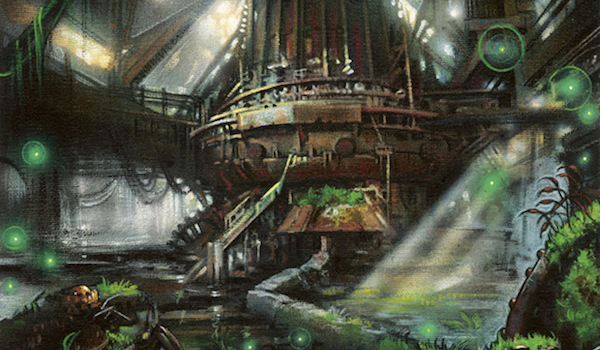
These are not new results or tests. Rather, these results are refinements of the previous two weeks of testing and some additional data collection. The big change comes from reexamining one of my results from the Jace test—I better understand now what the Bant Eldrazi results actually mean. The result was not statistically significant but it showed a large improvement, and I have a better handle on why. This also has additional implications for the viability of Jace, the Mind Sculptor in Modern.
A disclaimer before we begin: I stand by all my previous conclusions. All that data and the conclusions I drew from them are still correct. What my retests have done is refine those conclusions. I understand my data and what it all means far better now than when I published. Therefore it makes sense to pass this along to all of you. I will do so in reverse chronological order, starting with the bicycle lands.
Slow Ride
Last week I concluded that the new Life from the Loam engine was worse than normal Dredge. Despite being potent tools to dig through your deck or simply smooth out your draws, the bicyclers were too slow and mana-intensive to be worthwhile. Everything the deck was doing was simply more inefficient and slower than Dredge without a sufficient upside. This is still true—with a caveat I will get to below—but what I could not explain was why the decks I tried felt so wrong. I couldn't put my finger on any one thing at the time, but I just felt 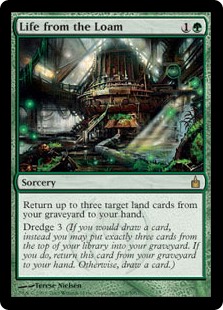 bad playing Loam decks. True, I don't like them as a strategy but that is not normally a problem. I test a lot of decks I don't enjoy playing because it's called testing. There was something else about Loam that made it uncomfortable to test, especially compared to the original versions.
bad playing Loam decks. True, I don't like them as a strategy but that is not normally a problem. I test a lot of decks I don't enjoy playing because it's called testing. There was something else about Loam that made it uncomfortable to test, especially compared to the original versions.
It wasn't until I was helping another player test their version of a Loam engine deck last week that I understood my problem. I wasn't doing anything. It wasn't just that the Loam engine is inherently durdly. I've played UW Control for years. The problem is that the durdling wasn't accomplishing anything. I know that sounds contradictory, so let me explain. Durdling is generally defined as doing a lot of things without advancing your boardstate. Typically this is accomplished by drawing cards and not doing anything with them. This is not necessarily a problem as long as you're not under pressure and/or you are drawing cards that will eventually push you towards victory. That wasn't happening in my Loam decks. If normal durdling is spinning your wheels then what I was doing was driving a wheelless car. I had the gas pedal to the floor, stuff was happening, but I wasn't going anywhere.
Failure to Start
The problem with the Loam engine is that it does nothing slowly. All of the problems I already knew about contributed to this. But what I didn't appreciate until I was skating to victory unmolested with UW Control was how much air Loam decks required. There just weren't many cards that did anything. Loam drew lots of cards and gained plenty of card advantage, but it didn't mean anything. At least when you draw cards and do nothing in UW Control you're building the resources to lock up the game. Here? Loam was using air to find more air. My opponent was many, many draws up on UW and was still behind in cards.
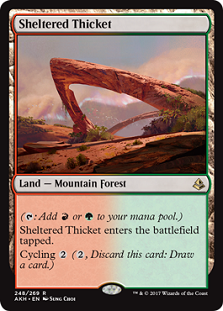 Consider the problem of building around the bicyclers. You need the bicyclers obviously, and they're pretty bad on their own in Modern. You need Loam, which doesn't really do anything on its own. And then you need the rest of the land base, the payoff spells and finally some enablers to help set it all up. It was a very slow and awkward combo deck, and they were ultimately terrible. So few cards matter in a vacuum that when you cannot find them fast enough in a real game your deck is blank.
Consider the problem of building around the bicyclers. You need the bicyclers obviously, and they're pretty bad on their own in Modern. You need Loam, which doesn't really do anything on its own. And then you need the rest of the land base, the payoff spells and finally some enablers to help set it all up. It was a very slow and awkward combo deck, and they were ultimately terrible. So few cards matter in a vacuum that when you cannot find them fast enough in a real game your deck is blank.
This problem could be fixed, but I don't think it's worthwhile. The older Loam decks were really Dredge decks before dedicated Dredge was good. Any attempt to build around the bicyclers would necessarily be clunky, slow, and lead you down the road to terrible combo decks. They are clunky and slow cantrips after all. As such I don't see anything coming from these cards.
A Long Shadow
That said, there may still be hope for a Loam combo deck. Shadow of the Grave is very potent and if the right shell can be found it might be good. It won't be found by me—my attempts have all been total failures—but I'm sure a list exists. A true combo Loam deck would use the titular card to find the lands so that you kill in one turn with Shadow. There's still the problem of Loam being slow, but if the rest of the deck is streamlined and fast enough, it may not matter. At the very least a deck like that would have no reason to slow down and pointlessly draw cards.
Tried and True
Next, lets go back two weeks to Gideon of the Trials in Ad Nauseam. I found that Gideon was a competitor with Phyrexian Unlife since it played better with Pacts and offered the potential to "gain" more life against certain aggro decks. At the time I speculated that being on the draw in my test games reduced Gideon's impact. Subsequent testing has confirmed that result. The more quickly that Gideon hits the board, the greater his impact. I stated in the comments of that article that Gideon vs. Unlife would come down to whether players valued Gideon's variable impact or Unlife's certainty more. I can confirm this—Gideon has a lower minimum value than Unlife but a much higher maximum.
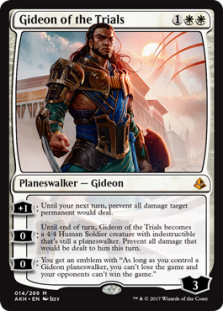 Additional testing, both with the original test decks and additional decks, showed that Unlife does effectively the same thing against every deck. You don't die from lethal damage and have an additional ten life as long as Unlife stays on the board. Nothing surprising. Gideon has many different outcomes. Against creature decks he represents a minimum of five life up to infinity. It is very unlikely that any deck will ever hit Gideon for exactly four, as the math of Modern threats and burn means they will almost certainly overkill him. Add to that the damage that Gideon's +1 directly prevents and the upside starts getting larger and larger, especially against decks that play few threats at a time. This impact grows larger when you're on the play rather than the draw. Unlife doesn't really care about die rolls.
Additional testing, both with the original test decks and additional decks, showed that Unlife does effectively the same thing against every deck. You don't die from lethal damage and have an additional ten life as long as Unlife stays on the board. Nothing surprising. Gideon has many different outcomes. Against creature decks he represents a minimum of five life up to infinity. It is very unlikely that any deck will ever hit Gideon for exactly four, as the math of Modern threats and burn means they will almost certainly overkill him. Add to that the damage that Gideon's +1 directly prevents and the upside starts getting larger and larger, especially against decks that play few threats at a time. This impact grows larger when you're on the play rather than the draw. Unlife doesn't really care about die rolls.
Furthermore, against UW, Unlife did very little while Gideon had some impact. When Boseiju, Who Shelters All wasn't a factor (most of the time) UW could sit back on its counters and Vendilion Clique, and Ad Nauseam would never resolve. Unlife's extra time really didn't matter. Gideon was an actual threat that had to be answered at some point. Because Gideon threatened your life total he couldn't be ignored, which helped Ad Naus find windows to go off. I had to leave in Paths against Ad Naus because of Gideon during testing. In my valuation, that's a good reason to make the switch.
The Question of Placement
The question that I cannot answer is how many Gideons and where. I think Ad Naus wants at least a few, but I don't know if they're maindeck or sideboard. His value is inherently swingy, dependent on both play/draw and the matchup. Thus I don't know if you just want him against control out of the sideboard or if you want a maindeck split. Even the actual Ad Naus player I was testing with who agreed with my conclusion isn't sure. It will be interesting to see, in any case, and players should prepare accordingly.
Clarity in Colorlessness
I was never happy with the Bant Eldrazi section from my Jace testing. I don't mean with the results or conclusions—experimental data is experimental data and it says what it says. I mean in the actual games. The regular Jeskai results were exactly in line with what we both expected, and we played the matchup well enough to be satisfied. But when it came to Jacekai (with Jace), neither I nor my opponent thought we played well.
I don't think I utilized Jace correctly. For my opponent's part, he decided midway through testing that he was playing suboptimally and that a different strategy was in order. However, it was far too late into testing to make the adjustments he wanted. He wanted to change so much about his playstyle that it would have invalidated everything we'd already done and that was not acceptable. Neither of us was willing or able to redo weeks of work.
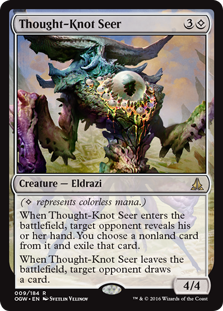 We both felt that we needed to mulligan more aggressively. Most of Jacekai's cards were relatively low impact, so I could give up some number of them to find the really important cards. I know that UW has a better matchup than Jeskai due to more hard removal, so I should have used my mulligans to try and see more UW cards rather than burn. My opponent felt that post-board he needed to be a prison-aggro deck and so had to mulligan for Chalice of the Void and/or Cavern of Souls. During the game he needed to be more judicious with his threats.
We both felt that we needed to mulligan more aggressively. Most of Jacekai's cards were relatively low impact, so I could give up some number of them to find the really important cards. I know that UW has a better matchup than Jeskai due to more hard removal, so I should have used my mulligans to try and see more UW cards rather than burn. My opponent felt that post-board he needed to be a prison-aggro deck and so had to mulligan for Chalice of the Void and/or Cavern of Souls. During the game he needed to be more judicious with his threats.
Additionally, both of us wanted to change how we played with Jace. I realized too late that I was too passive, Brainstorming all the time, when it would have been better to aggressively Unsummon monsters to crawl back some tempo. My opponent realized he was wrong about not attacking Jace since I was digging to Supreme Verdict, which is the best card I had against him. It was also very hard for me to win when I didn't have Jace on the board.
Finally, we both wanted to change our sideboarding. I should have been playing the Spreading Seas. Clique proved to be less impactful than I thought and the burn was bad. My opponent realized that he wanted Elspeth, Sun's Champion rather than Drowner of Hope.
Different Approach, Same Result
So, we made our changes, and tried a few matches to see if there was a difference. The total match wins would have been different, but I don't believe that my conclusions would have changed. We played seven full matches and Jacekai won four. There were a number of practice games beforehand. Seas was a big factor in many games, keeping Eldrazi off colorless mana, while Elspeth was a far more dangerous threat than the other non-Reality Smasher cards. My opponent went harder for the Chalice plan than before, but we didn't see a measurable impact. It is likely, had we the time and desire to do another hundred matches, that the result would be a few points lower than the original results, but not by much.
Implications
What really stood out for both of us and what prompted me to report this in the first place was how much better the games felt for Jacekai when I pretended I was really UW Control. Path to Exile and Blessed Alliance into Supreme Verdict with Cryptic Command was a monstrous beating for Eldrazi. Deliberately filtering through burn with Jace was a much 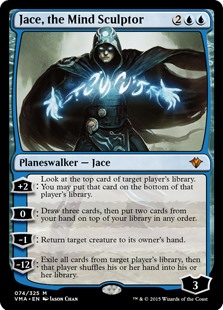 better strategy than I gave it credit for, meaning I actually didn't need to -1 Jace as much as planned. This leads me to believe that a repeat of the test with an UW Control deck would be a much clearer favorable result for Jace and a stronger case against an unban.
better strategy than I gave it credit for, meaning I actually didn't need to -1 Jace as much as planned. This leads me to believe that a repeat of the test with an UW Control deck would be a much clearer favorable result for Jace and a stronger case against an unban.
I initially thought that Jace would be favored in decks that want to see lots of cards. It made sense, Legacy decks that play him look to filter though lots of cards and that was my basis for comparison. During my testing I started questioning this assumption and this retest confirmed my doubts. Jace is good with lots of cards, but as individual card impact increases, the value of Jace also rises. Finding some burn is okay, but finding the sweeper you need is much better. I think that against the current meta, a UW deck with Jace would be overpowering. As such I'm more skeptical of unbanning Jace now than I was last month.
Looking Ahead
Next, I'm going to do something I might regret. I'm going to ask you what you want to see from the next banned card test. No restrictions. This won't directly determine the card I actually end up testing like last time. I'm just—interested isn't the right word—curious about what you want. Cards, decks, methods, whatever. I've mentioned my opinions on the banlist before, but I think it is important to get a feel for what the community believes. Of course, everyone's random opinions aren't as rigorous as actual testing. But at this time I need them to improve the series. At minimum, it will tell me what your pet cards and decks are, useful information for unrelated and more sinister plots. Go nuts comment section, I'll be lurking.


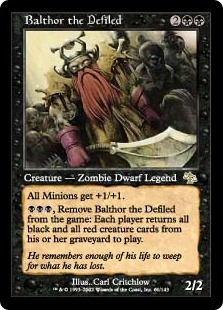


Well I would be remiss if I didn’t immediately say “Bloodbraid Elf please!”, the card that died for Deathrite Shaman’s sins.
Failing that, dig through time (assuming the best spot for it is RUG Scapeshift).
Dark Depths, I’m interested to see if it would actually be too powerful or if modern can deal with it.
not sure if a turn two 20/20 flyer with indestructible is too good or not?
Turn 1 dark depths. Turn 2 urborg, hexmage, win the game? Ouch. Don’t even forget that when depths was the best deck in extended, thespian’s stage hadn’t even been printed yet! Nah this one doesn’t need testing, I assure you. This one is lumped alongside Hypergenesis in the “never ever even if we’re drunk” pile lol
Hello !
Big Fan of your articles! I would be interested inthe implications of an unbanning of preordain/ponder, especially regarding the “new” Gift Storm.
Thx & BR
Thank You! Glad to hear it! Storm is the deck that got those cards banned (with some help) so that is where I’d probably test them.
Preordain and Dig Through Time, of course.
Test Dig Through Time!
Bloodbraid elf, Preordain, and Dig through Time are the most interesting. Each of their bans is tied up in other bans or different metas. Bloodbraid should be in a traditional jund list, probably not a Death’s Shadow version. Preordain should be in Gifts Storm, even though I think we need to ultimately ditch Grapeshot as a format. And Dig through time should be in some Grixis Control shell, you might have to base it on both current delver lists and current control lists.
People forget that you’ve already done Bloodbraid Elf…
Id like to see a test of one or all of the artifact lands.
I’d like to see Dig Through Time too. But in a Delver list similar to the Treasure Cruise era since it was banned due to the similar role of the two cards.
That would be the plan. Wizards did specify that they were worried about Dig replacing Cruise in UR Delver when they banned it.
Absolutely loving this series, thank you!
I love the way you’re approaching the articles at the moment so no suggestions there. Would like to see Preordain above all, appearing to me to be the most likely unban left to analyse. However it may be necessary to experiment with an unfair (Barak Storm) and fair (I would say Jeskai Nahiri, but I’m biased so maybe Grixis) deck to see the results in parallel.
I had that exact thought, and the extra work makes me leery of doing that card.
Really good article! Loved the parallel between your previous testing and reevaluating Jace.
And for potential further testing, mostly interested in Preordain and Bloodbraid Elf.
I would love to see generalized testing with Dig Through Time and the like, though what deck that goes in is difficult to nail down specifics of to make for meaningful testing.
What I would like to see more than anything else is a revisiting of Splinter Twin against a field of decks that would likely give it plenty of frustrations and headaches. Most notably against Death’s Shadow variants and Eldrazi, which didn’t exist as tired decks (or at all) when Twin was legal, and now represent a large portion of the best decks in the format.
That’s a fair point, though I’m not sure it would matter. Twin wasn’t really dominating when it was banned, Wizards thought it was keeping down other blue decks. On the basis that control is finally becoming a thing, even if Twin wouldn’t overpower the format, I suspect Wizards will keep it banned.
That said, it would be interesting to see if it is actually good anymore.
Not sure if you are mad or just really in love with data collection, to do this a third time in a row, but I 1) will not complain; 2) will thank you very much for the hard work you put in this series and 3) will be grateful if you could test preordain. Imo the shell should be an unfair one, since it is the most likely to break the card again (ad nauseam maybe?), even though I would be interested to see it at work in grixis delver. Cheers!
I assure you it is mostly madness.
Preordain
Raw data on Storm/Ad Nauseam Goldfish speed with/without preordain, followed by Storm/Ad Nauseam win rates vs discard heavy decks with/without preordain.
Would love to see:
Splinter Twin
Bloodbraid Elf
Preordain
Dark Depths
Green sun’s Zenith